Post-2020 global biodiversity framework - Edinburgh Process: report
This report details the outcomes of the Edinburgh Process for subnational and local governments and Edinburgh Declaration relating to the post-2020 biodiversity framework.
Annex 1 : Subnational views on the post-2020 global biodiversity framework
Goals, Targets And Monitoring Framework
1. When asked about their general view on the whether the 2030 Mission, Goals and Targets addressed the key biodiversity issues for subnational governments, city and local authorities (SNLG), the view was overwhelmingly positive with 66% saying yes, 33% saying somewhat and only 1% saying that they did not (figure 1).
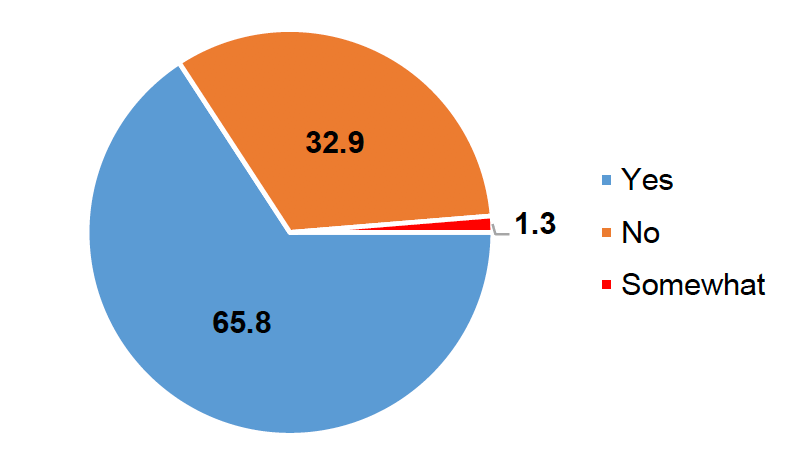
2. A key recurring theme raised by participants was the need for the role of SNLG in implementing the framework to be clearly highlighted in the post 2020 Global Biodiversity Framework and that vertical integration should be a key principal. SNLG are an integral part of government, therefore the mission, goals and targets apply equally to them as they do to state parties.
3. Participants highlighted the following general issues in relation to the framework:
- It was important that the post 2020 framework remains simple, clear and concrete with the role and importance of SNLG clearly indicated when it is strategic;
- SNLG have a critical role in mainstreaming due to their close links with stakeholders and business at the local scale and this should be recognised in the CBDs long term approach to mainstreaming biodiversity (LTAM);
- There should be a stronger link to the direct and indirect drivers of biodiversity loss set out in the IPBES Global Assessment;
- There is a lack of measureable targets in relation to some of the main threats for biodiversity, as set out in the IPBES report, particularly sector-based targets for agriculture and fisheries that specifically address declines;
- As the zero draft was developed before the Covid-19 crisis it was highlighted that there now needed to be a more specific reference to zoonotic pandemics building on the target 7 action to reduce human-wildlife conflict;
- Respondents highlighted the links between biodiversity and climate change and welcomed the increased focus on biodiversity's role as a solution to climate change in the framework but felt this could go further especially in relation to nature based solutions.
2050/2030 Goals
4. When asked their views on the on the 2050/2030 goals as set out in the zero draft of the framework respondents highlighted that the goals were an improvement on the previous goals as they were more targeted and specific but they should generally still be more 'SMART' (Specific, Measurable, Achievable, Realistic, and Time-bound) and better linked to the monitoring framework. Having both 2030 goals and 2030 action targets was confusing and did not help with the clarity of the message, and it may be better to focus the goals on the desired outcomes to achieve the 2050 vision. The mismatch between goal D and the other goals was also highlighted, which could be addressed through the use of sub goals across all goals. It is therefore welcome to see these changes already reflected in the updated zero draft.
5. Respondents questioned the language in the goal relating to the benefits derived from nature. Rather than nature providing benefits to people it should be turned around so that people can benefit from good and services provided by nature. The intrinsic value of biodiversity should also not be undervalued by resigning certain species and habitats to extinction/degradation simply because they do not provide optimised ecosystem services to humans. There were also calls for a specific reference to nature based solutions and the contribution they could make to achieving climate change mitigation and adaptation.
6. It was noted that Local Communities and Indigenous People have been coexisting with nature in areas of rich biodiversity for millennia and their views needed to be taken on-board before commercial interests. Traditional knowledge generate by such communities should also be owned by those communities and not state parties as this appropriation results in indigenous peoples being less willing to share such knowledge.
7. Respondents also highlighted that some areas were underexposed in the goals, including ecological footprint, mainstreaming, urban greening and health, through peoples connection with nature.
Targets
8. Respondents provided their views on the action targets, as set out in the zero draft framework: a. Reducing threats to Biodiversity
- The link between the targets and the drivers of biodiversity set out in the IPBES global assessment should be strengthened with clear, measureable targets that address the five direct drivers.
- In relation to species-related targets there is too much focus on species that are important for socio-economic reasons rather than their own intrinsic value.
- The targets are not as clear and concise as they could be and in some cases contained multiple elements which could hinder implementation, e.g. the target on pollution where a general reduction target was applied to all pollutants, without differentiation between pollution types. This could be addressed by including sub targets. Again it is welcome to see this addressed in the update version of the Zero draft published on the 17 Aug 2020.
- The closer linking of the Climate and Biodiversity agendas was welcomed but could be refocused from the Paris agreement targets - which may not be within the remit of the CBD - to increasing and protecting known carbon stores and implementing nature based solutions at all levels of government.
- Respondents generally considered that the targets are action and outcome focused but in keeping a maximum of 20 targets, whilst placing greater emphasis on meeting people's needs through sustainable use and benefit-sharing, the Zero Draft has lost specificity for a number of sector based targets - in particular fisheries and aquaculture, which are no longer directly referenced unlike agriculture. Lowering the visibility of these sectors will not convey the required political priority and urgency.
- The impacts of the coronavirus COVID-19 pandemic, the lockdown restrictions and the resulting economic recession have not been shared equally across society. Similarly, the future impacts of climate change and the loss of nature will not be borne equally by all therefore interventions that will benefit sectors of society most heavily impacted by the climate and nature emergency and the pandemic, e.g. improving access to nature, should be prioritised.
- A more specific reference to zoonotic pandemics - building on the target to reduce human-wildlife conflict - would provide an important hook for governments of all levels to take action towards a fundamentally greener future with more positive outcomes for biodiversity.
- The targets in this section lack sufficient clarity and direction in terms of pressures and drivers, and the draft indicators tended to be too process-based rather than focusing on ecological outcomes.
- The clearer the global targets the better subnational and local governments - which have unique and essential capacity for on-the-ground local and regional delivery of ecological outcomes - will be able to construct local action that will contribute to the 2050 goals.
- The target on mainstreaming biodiversity is welcomed, particularly the link to planning at all levels however an even more explicit reference to SNLG would be welcome to ensure that that there is a clear hook for policy makers. It was also felt that specific objective on EIA and SEA should move to a sub target to avoid multiple objectives in the same target, and recognised tools that measure results should be used (such as natural capital accounting) otherwise the target would be difficult to measure.
- Targets covering people's individual actions, education, and effective access could be more concise or combined to allow for expansion in other parts of the framework.
- One respondent suggested that there should be a target on effective governance added to the framework.
We note that these final two points have been somewhat addressed in the updated Zero Draft document.
Ambition
9. The general view on overall ambition of the zero draft framework was positive with 63% stating that the level was sufficient, 31% saying it was somewhat sufficient and only 6% saying it was not sufficient (fig. 2).
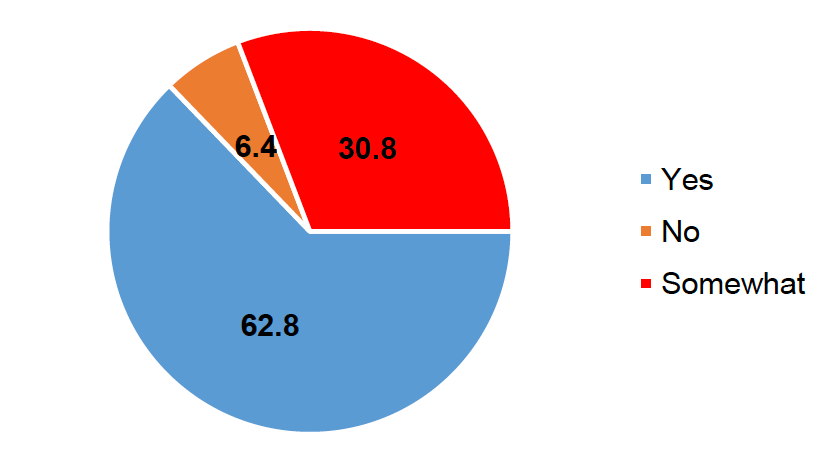
10. The overall level of ambition was considered to be towards what is needed to set us on the road to recovery, however much of this will depend upon the how the final negotiations play out. Respondents highlighted that;
- levels of ambition should not differ between national, subnational and local governments - all jurisdictions should feel challenged to raise their ambition for the next framework to engender meaningful action.
- the ambition of the subnational governments can be a lever for the ambition of the state parties. It is important to ensure the inclusion of the role and importance of all governments (including sub-national and local) and stakeholders (civil society and private sector) in order to engage with those constituencies.
- Greater ambition is needed, recognising that 2021-2030 is the UN Decade of Ecosystem Restoration. As it stands, the target relating to ecosystem retention and restoration is less ambitious than the previous Aichi targets, as spatial planning doesn't guarantee restoration, and could benefit from being split into sub targets including focusing on the restoration of habitats that store carbon.
Monitoring Framework
11. When asked, 67% of participants considered that generally the Monitoring Framework was not, or only somewhat, effective for monitoring the action targets at subnational level, with 33% indicating that the framework was sufficient (fig. 3). These responses were submitted on the Zero Draft version of the monitoring framework prior to the updated version included in the SBSTTA peer review.
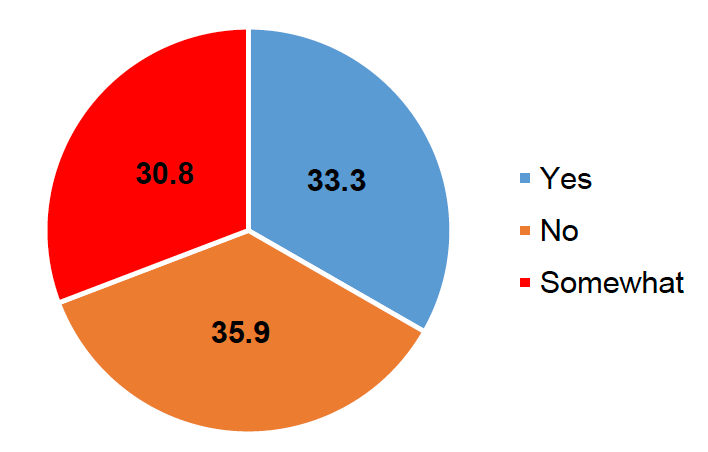
12. Respondents also indicated;
- Welcome inclusion of the monitoring framework as an integral part of the framework - a significant improvement on the Aichi targets where this was only considered afterwards. However the Monitoring Framework was more coherent for the targets than for the goals.
- The indicators should be reflective of the numerical metrics in the goals. There seems to be a disconnect between these for multiple goals, e.g. nature based solutions are addressed both in the goals and targets but there are no indicators on the implementation of NBS and how they deliver multiple benefits and enhance the integrity of ecosystems. *This has been addressed in the updated Zero Draft document.
- It is important to ensure that SNLG that wish to monitor and report on the implementation of their commitments can do so through the next global biodiversity framework – though more direct inclusion of implementation by all levels of government; adding references to SBSAPs and LBSAPs, and; having SMART objectives that are easily transposable to all levels of governance.
- The existing indicators used at this stage (either from the Aichi targets or SDGs) may not be suitable to clearly monitor progress in implementing the new targets, e.g. target 6 indicators relate to deforestation and don't contain any indicators for other carbon-storage habitats (peatlands or blue carbon).
- The monitoring framework adopted now should remain in place for the period up to 2050, to allow the development of indictors, baselines and datasets that can monitor progress in the long term.
- Monitoring and reporting on progress is critical in order to capture the collective actions of subnational and local governments in measuring overall implementation of the post-2020 global biodiversity framework.
- SNLG need to have a clear role and responsibility for indicators that relate to data that they are best suited to collect and provide, through vertical integration and the development of tools for all levels. Resources to carry out these activities are essential and the use of citizen scientists in monitoring should be encouraged to empower, engage and contribute.
- A direct and demonstrable link should be made from delivery against each indicator and measurable benefits for nature. The roles of the targets, elements, and indicators needed to be clearly set out, e.g. the 'elements' column appears to be central in delivery of positive outcomes, but the relative weight of the different elements - in terms of that delivery - is not yet clear. Further guidance should be included in the monitoring framework including clear definitions for the elements to be monitored.
- Concern was raised that in some instances positive indicators may not deliver tangible benefit for nature. Some of the indicators for 'use' of biodiversity emphasise the number of people who derive benefits, without fully and explicitly incorporating sustainability. This could lead to confused or perverse interpretations and elevated exploitation with implications for fisheries management, for example.
- Most topics in the monitoring framework are in some way relevant at the subnational level, but many are not clearly connected to legally binding responsibilities and regular roles of SNLG. Successful mainstreaming relies on clarifying status and responsibility of particular organisations at the subnational level and allocating relevant assignments. Not all SNLG would be able to provide data for all the elements due to the effort required, so that there was a need to clearly identify where they were best placed to contribute data, and put in place arrangements to facilitate its delivery.
- One respondent highlighted that despite the success of the Biodiversity Indictors Partnership over the last 10 years the CBD needs to develop a more comprehensive approach to indicator development and data management to ensure progress in implementing the post 2020 Global Biodiversity Framework up to 2050 can be measured.
- Ensuring data availability and establishing baselines, from which progress / success will be measured, will be essential but challenging. There is also a need for the framework to address the interplay between the global indicators and regional or national indicators that are already being used in different parts of the world and how these can be used. This could have formed a proposal for a decision on data, monitoring and assessment to sit alongside those on resource mobilisation, capacity building and mainstreaming that will be presented to SBI-3.
- There was a need to have elements or indicators on the participation of SNLG in the section on tools and solutions for implementation and mainstreaming, particularly on the adoption of LBSAPs and nature based solutions.
- There should be stronger elements and indicators on mainstreaming biodiversity into other sectors and policy areas
- There is a need to develop indicators on target 11 on access to and benefits of greenspace. These should include the quality/diversity of these spaces.
- The marine elements of the monitoring framework in particular do not always fit with the proposed targets and goals under the Post 2020 GBF. An example for this is Target 1 where most of the elements to be monitored and indicators are land based and when there are marine indicators they are general indexes that are unlikely to give a clear answer in relation to the element to be monitored.
- There should be an indicator on conservation of traditional knowledge under ABS (Nagoya Protocol)
- There is a need for consistent and industry standard tools for monitoring implementation, at present there are too many approaches.
14. Comments received from Edinburgh Process participants were collated and fed into the Open Ended Working Group peer review process for the draft monitoring framework, which closed on 25 July, 2020. The full Edinburgh Process submission can be accessed through the CBD webpages.
Key Points on Goals, Targets and Monitoring Framework
- The role of subnational and local governments need to be clearly recognised within all relevant sections of the framework to ensure that it is politically relevant, vertically integrated and governments at all levels feel responsibility for its implementation.
- Subnational and local governments are well placed to address mainstreaming, in line with the long-term strategic approach, due their closer links to stakeholders, including businesses, NGOs and local communities and indigenous peoples.
- It is critical to capture the collective actions of subnational governments, cities and local authorities in measuring the overall implementation of the post-2020 global biodiversity framework.
- Therefore the monitoring framework should be explicit in setting out which monitoring elements should be undertaken at which level of governance, so that the appropriate resources can be put in place.
- The ambition of the subnational governments can act as a lever for the ambition of state parties. It is therefore important include all levels of governments (including sub-national and local) and stakeholders (civil society and private sector) in order to engage with the whole of society.
Engagement across levels of Government
15. Respondents were asked a second series of questions related to the involvement of SNLG in CBD and national processes. Across 80 written submissions, most respondents were already engaged in the development of the post-2020 framework either through participating in CBD process (53%) or through Subnational Networks (43%), with only 14% not having any prior engagement (fig 4).
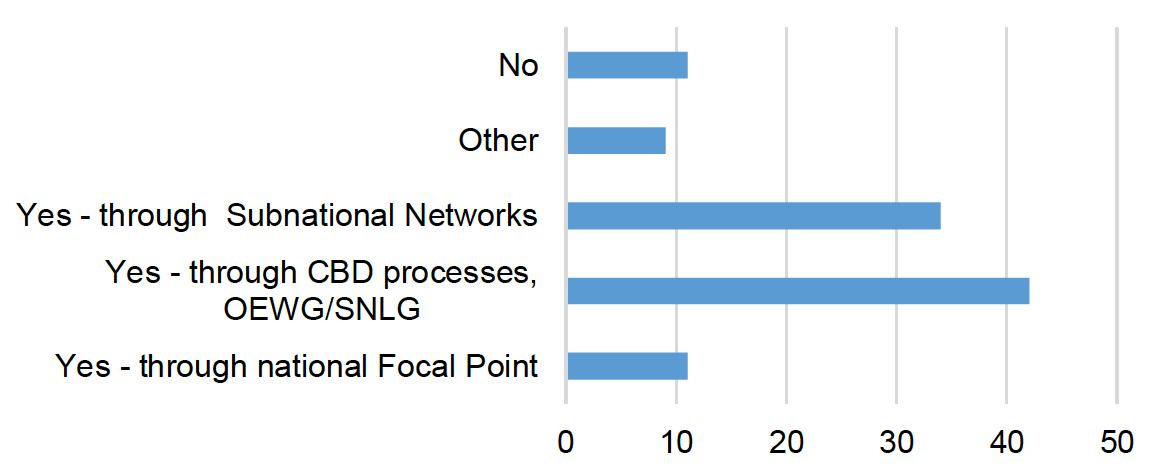
16. Whilst it is not surprising that participants to the Edinburgh Process are actively involved in the framework development, it is somewhat surprising that only 14% of respondents had been engaged with their National Focal Point (NFP). This suggests that there is still a disconnect between national and subnational authorities in many cases and there are opportunities for better vertical integration and improved collaboration.
17. This is mirrored when considering biodiversity strategies and action plans with the majority of consultees having or putting in place an LBSAPs (53%) and a further 35% would implement a plan if resources were available. Only a third of respondents (34%) had any involvement in the development of their NBSAP despite the vast majority of respondents (88%) stating that given the opportunity they would actively contribute to the development of their NBSAP.
18. Consultees highlighted the following areas for improvement between national and subnational/local authorities; i) greater communication in general between levels of government to improve levels of knowledge, understanding and relevance of contributions at local level; ii) clarification of the relationship between local level and national level actions and targets, and in respect of rural versus urban actions contributing to national targets.
19. For national-level reporting, three quarters (75%) of respondents indicated that they do notcontribute, or did not have the opportunity to contribute, to a national report co-ordinated by their NFP. A majority (91%) of those not currently contributing would be willing to do so, given the opportunity in future (fig 5).
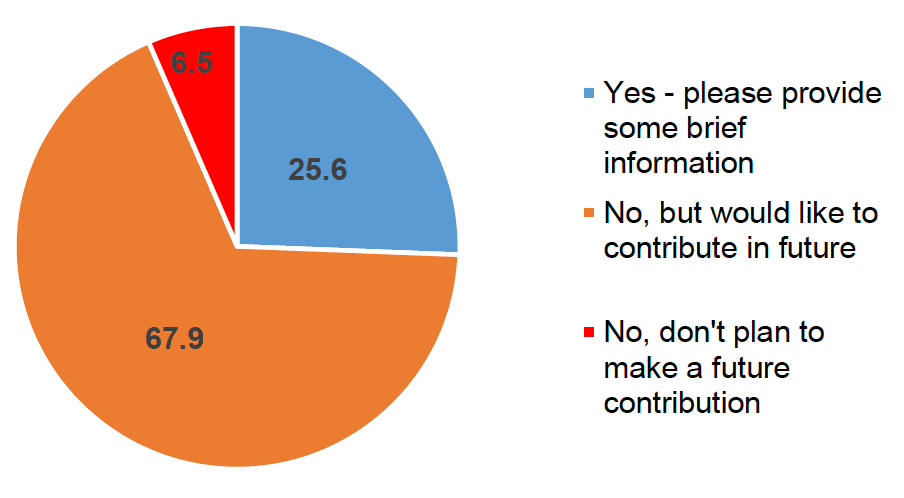
20. The main reason cited for lack of input was the absence of contact and consultation by the National Focal Point, or their third party (often agency) reporting/drafting team. Centralisation of reporting and monitoring issues was also an issue. For some there was a lack of clarity of whether contributions provided by subnational and local authorities are fully taken into account.
21. One quarter (25%) of respondents indicated that they had contributed to National Reports through positive and active engagement with their NFP, or representative agency. This was actioned through provision of monitoring and reporting data, involvement in workshops, drafting and reviewing. For some there is a legal duty to report.
22. This issue was further explored through the Monitoring and Reporting Tools webinar, and there was general recognition that monitoring and reporting on progress is critical in order to capture the collective actions of cities and regions in measuring overall implementation of the post-2020 framework. It is critical that the framework is explicit on the role of SNLG in its goals and action targets, and that consideration is given to monitoring and reporting on progress at the local and subnational level in the monitoring framework of the post-2020 global biodiversity framework.
Key Points on Engagement
- Better vertical harmonisation and co-operation are needed to improve engagement of a majority of NFP with their subnational and local counterparts.
- Many NBSAPs and national reporting do not take into account the requirements, actions and resources of subnational and local authorities.
- Monitoring activities at subnational levels are critical components of national contributions and this should be recognised within the post-2020 global biodiversity framework.
Implementation
23. In considering the elements related to implementation of the post-2020 global biodiversity framework, a majority of Edinburgh Process respondents (60%) considered that the issues set out in sections E-H of the Zero Draft document would provide a sufficient framework for ensuring subnational contributions. Those who answered no (8%) or somewhat (32%), set out issues that they consider are missing and which would support SNLG in successfully implementing the Framework (fig 6);
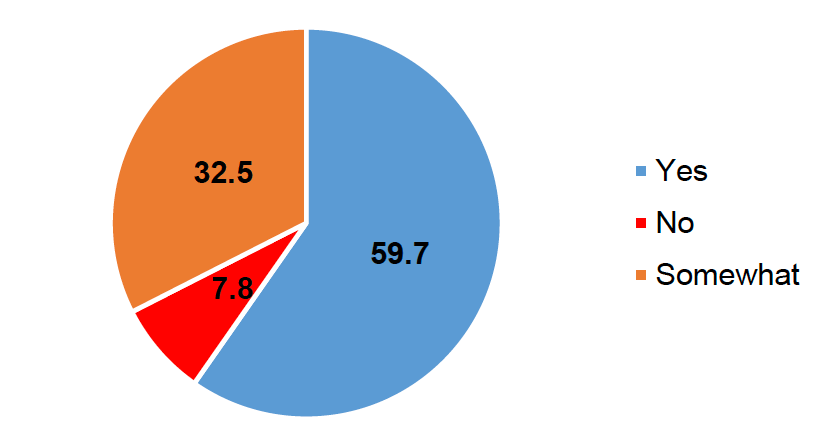
a. Implementing support mechanisms
24. A general consensus emerged that this section of the Zero Draft is overly focused on Parties and that the roles of each actor are not clear. Gaps include;
- Consideration of the strong role of SNLG in providing available resources – in terms of both people and finance;
- The zero draft text calls for 'an increase in resources from all sources' however there is a need to quantify what constitutes 'sufficient' resources, and who provides the resources;
- The need to have in place appropriate economic instruments, e.g. conservation finance, with the support of business and wider society in order to support implementation of biodiversity action at local levels and recognising the coherence with SDG15 - "Mobilize and significantly increase financial resources from all sources to conserve and sustainably use biodiversity and ecosystems";
- Across the issues of capacity building, knowledge and information sharing and technical co-operation, technology transfer and innovation, there was a wide recognition that SNLG play a critical role in engaging effectively with a wide range of stakeholders, as well as their national counterpart. This engagement aligns with the outreach, awareness and uptake aspect of the framework.
b. Enabling conditions
25. There was general recognition that subnational authorities are contributing to national and global strategies, e.g. SDGs, in ways that are not often visible and this should be better recognised; political will is perhaps the most important aspect to enabling effective actions and this should be placed more prominently within the framework to ensure engagement from national level with subnational and local authorities, as well as "all relevant stakeholders"; harmonisation of policies across global, national and subnational/local levels was recognised as essential. Subnational policies often align to - therefore contribute to - global and/or national strategies, e.g. SDGs, and this needs to be recognised; harmonisation across private and public sectors is also important to ensure that enabling finance mechanisms are in place – leveraging from bottom up as well as top down. Discussions at the NBS and Resource Mobilisation webinars reflected that often bottom-up, business-led nature based solutions are most effective in delivering biodiversity benefits across local level landscapes.
c. Responsibility and transparency
26. In ensuring that the commitments set out in the Framework are properly monitored and reviewed, not only are national commitments important but subnational and/or regional/local commitments should be taken into account. When considering national reporting, drafting and implementation should include all stakeholders involved – particularly subnational and local authorities. Within the Framework it should be made clear who is accountable for what; there is an need for better assessment and measurement - at both national and subnational levels - to quantify engagement, implementation, action and monitoring, in order to 'sufficiently guarantee progress in the face of ongoing current biodiversity loss'; decentralisation of biodiversity issues was considered as essential by some respondents, to providing the most effective contribution - through the identification of finance, people and scientific research, appropriate for their specific locality and biological ecosystems.
27. Some respondents suggested specific indicators for inclusion in the monitoring framework in order to assess the level and effectiveness of implementation, e.g. the percentage of biodiversity integration in national level laws /decisions; number of NGOs working on (and cost of) specific programmes on Biodiversity issues; contribution of municipalities/local governments to biodiversity conservation (i.e. programmes & funding); required staffing per unit area or per human population.
d. Outreach, awareness and uptake
28. Subnational and local governments play a key role in explaining biodiversity action to, and engaging with, their local stakeholders across both private and public sectors. Respondents recognised that in the post-COVID world there will be an increasing need to use virtual engagement tools to ensure effective communication across all sections of society over the coming decade. There was a general recognition to the high commitment of subnational and local authorities, who are managing different ecosystems and biodiversity across different continents, therefore there is a need for Parties to meaningfully and consistently engage with this level of government.
Critical Elements for Implementation
29. In asking what are the most important elements for subnational authorities, enabling conditions and support mechanisms were commonly mentioned; and aligned to making the most effective use of partnerships, stakeholder and whole-of-society engagement through outreach, and awareness-raising.
30. It is key that subnational and local authorities are recognised across the framework as critical to delivery of the framework. Decentralisation of biodiversity issues is essential to create the supportive conditions (people and funding) needed for specific local and regional ecosystems and to ensure that local projects are undertaken as needed with effective data collection and reporting platforms in place.
31. Vertical integration and harmonisation across all levels of governance was thought critical in delivering a coherent implementation of the framework, including greater mainstreaming of biodiversity across policy areas. The need for a commitment by national and subnational level political leaders is critical and there needs to be alignment of national guidelines with subnational policies.
32. Though the Resource Mobilisation webinar it was recognised that whilst top-down approaches to financing for biodiversity and conservation have been extremely helpful, bottom-up approaches – involving local stakeholders, e.g. businesses and NGOs, and in partnership with public bodies – can deliver where there is a need for change across local landscapes. Successful delivery of financial resources relies upon effective mainstreaming approaches.
33. There was a call for a definitive implementation plan and a formal mandate for participation and action by subnational and local authorities, with the framework setting out the clear responsibilities and tasks of subnational and local governments.
34. Through our webinar on Nature Based Solutions, participants to the Edinburgh Process recognised that capacity building is crucial for fostering knowledge exchange, bringing different actors together, building trust for investors in nature-based solutions and for harnessing the community value and benefits of nature-based solutions. Enabling conditions are necessary for the implementation of NBS including measures such as investments and legal incentives, increasing their visibility and improving abilities to scale-up local NBS. A convergence of the biodiversity agenda with other international agendas such as the Sustainable Development Goals and the climate agenda would strengthen the position and importance of both the biodiversity agenda and NBS as a means to address multiple challenges simultaneously. This alignment is most effectively achieved at the level of subnational governments, cities and local authorities.
35. In the Zero Draft document, subnational governments, cities and local authorities are referenced only under enabling conditions - alongside other stakeholders. This does not represent their wider responsibility in implementing the post-2020 GBF.It is noted that aspects related to implementation have been addressed in the updated zero draft document, however specific reference to SNLG remain limited to the Enabling Conditions section of the framework, with references to 'government at all levels'; 'all actors'; and 'non-State actors' mentioned in other sections. This does not fully recognise the specific role that SNLG has to play across all areas of implementing the framework.
Key Points on Implementation
- SNLG are an integral part of government, therefore the mission, goals and targets apply equally to them as they do to state parties.
- Across the issues of capacity building, knowledge and information sharing and technical co-operation, technology transfer and innovation SNLG play a critical role in engaging effectively with a wide range of stakeholders, as well as their national counterpart. This engagement aligns with the outreach, awareness and uptake aspect of the framework.
- Vertical integration and harmonisation across all levels of governance - global, national and subnational/local - is critical in delivering a coherent implementation of the framework.
- Harmonisation across private and public sectors is critical in ensuring finance mechanisms are in place – leveraging from bottom up as well as top down, and recognising that that often bottom-up, business-led nature based solutions are most effective in delivering biodiversity benefits across local level landscapes.
- NBS provide opportunities to address multiple challenges, simultaneously. Alignment of cross-convention issues is most effectively achieved at the level of subnational governments, cities and local authorities
- SNLG should be recognised across the framework as critical to its delivery. Decentralisation of biodiversity issues is essential to create the supportive conditions (people and funding) needed for specific local and regional ecosystems and to ensure that local projects are undertaken as needed with effective data collection and reporting platforms in place.
- There was a call for a definitive implementation plan and a formal mandate for participation and action by subnational and local authorities, with the framework setting out the clear responsibilities and tasks of subnational and local governments.
Contact
There is a problem
Thanks for your feedback